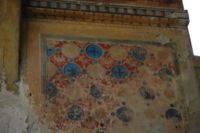
Okopy, Ternopil Oblast
Encyclopedia

Village
A village is a clustered human settlement or community, larger than a hamlet with the population ranging from a few hundred to a few thousand , Though often located in rural areas, the term urban village is also applied to certain urban neighbourhoods, such as the West Village in Manhattan, New...
(selo) in western Ukraine
Ukraine
Ukraine is a country in Eastern Europe. It has an area of 603,628 km², making it the second largest contiguous country on the European continent, after Russia...
. It is located in the Borshchiv Raion
Borshchiv Raion
Borshchiv raion is a raion Borshchiv raion is a raion Borshchiv raion is a raion (a district within Ternopil Oblast (province) in western Ukraine, an area known as Galicia. The administrative center of the raion is Borshchiv.-Demographics:The district's population is 75,358...
(district
Raion
A raion is a type of administrative unit of several post-Soviet countries. The term, which is from French rayon 'honeycomb, department,' describes both a type of a subnational entity and a division of a city, and is commonly translated in English as "district"...
) of the Ternopil Oblast
Ternopil Oblast
Ternopil Oblast is an oblast' of Ukraine. Its administrative center is Ternopil, through which flows the Seret River, a tributary of the Dnister.-Geography:...
(province
Oblast
Oblast is a type of administrative division in Slavic countries, including some countries of the former Soviet Union. The word "oblast" is a loanword in English, but it is nevertheless often translated as "area", "zone", "province", or "region"...
), and had its origins as a Polish
Poland
Poland , officially the Republic of Poland , is a country in Central Europe bordered by Germany to the west; the Czech Republic and Slovakia to the south; Ukraine, Belarus and Lithuania to the east; and the Baltic Sea and Kaliningrad Oblast, a Russian exclave, to the north...
fortress at the meeting of the Zbruch and Dniester
Dniester
The Dniester is a river in Eastern Europe. It runs through Ukraine and Moldova and separates most of Moldova's territory from the breakaway de facto state of Transnistria.-Names:...
rivers.
The current estimated population is around 557 (as of 2005).
Name
The settlement was previously referred to as Okopy Svyatoyi Triytsi , translated as the Ramparts of the Holy Trinity.History
The stronghold and the neighbouring town were built in 1692, by Stanisław Jan Jabłonowski, Grand Hetman of the Crown. The site was chosen by King Jan III Sobieski of Poland, as a measure to stop a possible attack from the nearby TurkishTurkey
Turkey , known officially as the Republic of Turkey , is a Eurasian country located in Western Asia and in East Thrace in Southeastern Europe...
-seized fortresses of Kamieniec Podolski, twenty kilometers away, and Chocim, eight kilometers away. The fortress was expanded by Tylman of Gameren, one of the most notable Polish architects of the time.
The site is a natural fortress: a small strip of high rocks linking the Zbruch and Dnister rivers. Tylman of Gameren decided to build a double line of fortifications (two rampart
Defensive wall
A defensive wall is a fortification used to protect a city or settlement from potential aggressors. In ancient to modern times, they were used to enclose settlements...
lines of bastion
Bastion
A bastion, or a bulwark, is a structure projecting outward from the main enclosure of a fortification, situated in both corners of a straight wall , facilitating active defence against assaulting troops...
system) with two gates leading east- (Kamieniec Gate) and westwards (Lwów Gate). Other directions were defended by towered walls and natural escarpements over the river banks, with walls stretching along both sides of isthmus
Isthmus
An isthmus is a narrow strip of land connecting two larger land areas usually with waterforms on either side.Canals are often built through isthmuses where they may be particularly advantageous to create a shortcut for marine transportation...
on the edge of steep slope to the river. The construction was started under the command of the General of Horse Artillery, Marcin Katski, and the works were finished in the same year. The nearby village was also fortified. In 1693 Jan III Sobieski built a votive church in the compound. Israel ben Eliezer, a Jewish mystical
Mysticism
Mysticism is the knowledge of, and especially the personal experience of, states of consciousness, i.e. levels of being, beyond normal human perception, including experience and even communion with a supreme being.-Classical origins:...
rabbi
Rabbi
In Judaism, a rabbi is a teacher of Torah. This title derives from the Hebrew word רבי , meaning "My Master" , which is the way a student would address a master of Torah...
, and the founder of the Hasidic Jewish movement, one of the most important Jewish denominations, was born in Okopy in 1698.
The stronghold was abandoned in 1699, when the rest of Podolia
Podolia
The region of Podolia is an historical region in the west-central and south-west portions of present-day Ukraine, corresponding to Khmelnytskyi Oblast and Vinnytsia Oblast. Northern Transnistria, in Moldova, is also a part of Podolia...
was returned to Poland
Poland
Poland , officially the Republic of Poland , is a country in Central Europe bordered by Germany to the west; the Czech Republic and Slovakia to the south; Ukraine, Belarus and Lithuania to the east; and the Baltic Sea and Kaliningrad Oblast, a Russian exclave, to the north...
, and the fortress lost its importance as a counterbalance to Kamieniec Podolski. In 1769, the Bar Confederacy, defended the stronghold against the besieging forces of Russia
Russia
Russia or , officially known as both Russia and the Russian Federation , is a country in northern Eurasia. It is a federal semi-presidential republic, comprising 83 federal subjects...
. The defence was commanded by the further Hero of the American Revolutionary War
American Revolutionary War
The American Revolutionary War , the American War of Independence, or simply the Revolutionary War, began as a war between the Kingdom of Great Britain and thirteen British colonies in North America, and ended in a global war between several European great powers.The war was the result of the...
, Kazimierz Pułaski.
After the Partitions of Poland
Partitions of Poland
The Partitions of Poland or Partitions of the Polish–Lithuanian Commonwealth took place in the second half of the 18th century and ended the existence of the Polish–Lithuanian Commonwealth, resulting in the elimination of sovereign Poland for 123 years...
in 1772, the village and the ruins of the stronghold, became the easternmost point of Austria
Austria
Austria , officially the Republic of Austria , is a landlocked country of roughly 8.4 million people in Central Europe. It is bordered by the Czech Republic and Germany to the north, Slovakia and Hungary to the east, Slovenia and Italy to the south, and Switzerland and Liechtenstein to the...
n Galicia. The nearby town was abandoned, and the inhabitants of the village moved inside of the fortress walls. Most of the houses that were built, were made from the stones that had been used to construct the earlier defensive walls. The remaining parts of the stronghold (both gates, one of the forts, the ruins of the Holy Trinity church and parts of the walls) were partially restored in 1905, by count Mieczysław Dunin-Borkowski.
After the Polish-Bolshevik War
Polish-Soviet War
The Polish–Soviet War was an armed conflict between Soviet Russia and Soviet Ukraine and the Second Polish Republic and the Ukrainian People's Republic—four states in post–World War I Europe...
of 1920, the site was made part of Poland
Second Polish Republic
The Second Polish Republic, Second Commonwealth of Poland or interwar Poland refers to Poland between the two world wars; a period in Polish history in which Poland was restored as an independent state. Officially known as the Republic of Poland or the Commonwealth of Poland , the Polish state was...
, in the Tarnopol Voivodship, near the Polish border with the Soviet Union
Soviet Union
The Soviet Union , officially the Union of Soviet Socialist Republics , was a constitutionally socialist state that existed in Eurasia between 1922 and 1991....
and Romania
Romania
Romania is a country located at the crossroads of Central and Southeastern Europe, on the Lower Danube, within and outside the Carpathian arch, bordering on the Black Sea...
. The 14th battalion of the Border Defence Corps were stationed there. In the interbellum, the village was known for its wineries and peach orchards. It became a holidays center for the inhabitants of the nearby cities of Ternopil
Ternopil
Ternopil , is a city in western Ukraine, located on the banks of the Seret River. Ternopil is one of the major cities of Western Ukraine and the historical region of Galicia...
, and Lviv
Lviv
Lviv is a city in western Ukraine. The city is regarded as one of the main cultural centres of today's Ukraine and historically has also been a major Polish and Jewish cultural center, as Poles and Jews were the two main ethnicities of the city until the outbreak of World War II and the following...
.
After the World War II
World War II
World War II, or the Second World War , was a global conflict lasting from 1939 to 1945, involving most of the world's nations—including all of the great powers—eventually forming two opposing military alliances: the Allies and the Axis...
, the site was annexed by the Soviet Union
Soviet Union
The Soviet Union , officially the Union of Soviet Socialist Republics , was a constitutionally socialist state that existed in Eurasia between 1922 and 1991....
. The village was renamed "Okopy" and was turned into a Kolkhoz
Kolkhoz
A kolkhoz , plural kolkhozy, was a form of collective farming in the Soviet Union that existed along with state farms . The word is a contraction of коллекти́вное хозя́йство, or "collective farm", while sovkhoz is a contraction of советское хозяйство...
, and soon totally depopulated, as a result of the forced migration of Poles to Siberia.
The ruins of the stronghold can be found in the western part of the village.
The name of the fortress was popularized in Poland by Zygmunt Krasiński
Zygmunt Krasinski
Count Napoleon Stanisław Adam Ludwig Zygmunt Krasiński , a Polish count, is traditionally ranked with Mickiewicz and Słowacki as one of Poland's Three National Bards — the trio of great Romantic poets who influenced national consciousness during the period of Poland's political bondage.-Life and...
in his poem "Nie-Boska komedia" (Un-divine Comedy).

